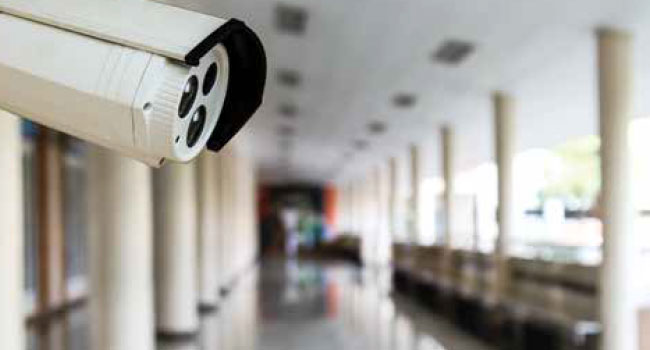
Perimeter Protection
Security solution advances drive reevaluation of campus security
- By Bruce Canal
- October 01, 2019
According to the National Center for Education Statistics
(NCES), 95 percent of public schools engaged in
lockdown drills designed to protect students in the
event of an intruder on campus during the 2015-16
school year—a number that has likely grown in the
intervening years. It is an astonishingly high percentage, and it effectively
drives home the ubiquity of campus security concerns in the
United States. There are laws mandating the performance of these
drills in 32 of 50 states, from K-8 schools to high schools and colleges.
Ensuring that students can play, learn, and grow in a secure environment
is perhaps the highest priority in the education field.
Drills play an important role in keeping students safe, but they
center around understanding what to do when an incident is already
in progress. In addition to establishing proper response procedures, a
comprehensive approach must include prevention-focused security
measures. Today, there are more tools available than ever to establish
strong perimeter security and help campus security teams identify
intruders and potential threats before they arise.
Smarter Tools are Changing the Campus Security Game
Public perception of school security tends to lag a little behind the
times. For many, the idea calls to mind sash-wearing hall monitors,
or perhaps a single school resource officer stationed near a high-traffic
hallway. Even the more technology-focused solutions fail to accurately
represent the tools available today: metal detectors and walls of
security monitors might still be a part of the solution in some cases,
but they fall short of representing the depth and breadth of today’s
access control and monitoring resources.
The truth is that, as concern for campus safety has blossomed, so
too has the development of more innovative, affordable, and effective
tools for monitoring and controlling the perimeter of campus buildings.
The NCES notes that 81 percent of schools include cameras as
part of their security solution. But what does this mean, exactly?
While it’s nice to know that a school uses cameras as a security measure,
how those cameras are being monitored matters.
The difference between traditional, analog security cameras and
today’s IP cameras is as vast as the difference between the tape deck in a 1995 Ford Thunderbird and the Bluetooth connection in a 2018
Tesla Roadster. Analog cameras require a human to be actively
engaged with the camera system, and even those schools that can
afford dedicated security personnel must face the reality that a
human being really can’t look at a wall of 12-16 cameras and fully
process what they’re seeing. For this reason, we have found that
more cameras do not necessarily imply better security. If the security
staff monioring a 200-camera system cannot comprehend what
they’re seeing quickly or reliably enough to take action, what, then,
is the point?
Better Tools Create Better Results
Today’s tools address this challenge in a novel way: by removing the
human factor. Where analog cameras require someone to notice suspicious
or out-of-place activity, IP cameras can detect it automatically.
Security teams can program cameras to alert the appropriate
authorities or personnel if certain conditions are met. These parameters
might include motion detection to identify intruders, supported
by size parameters to prevent a squirrel from tripping the alarm.
These cameras can help campuses increase their surveillance coverage
with fewer cameras, and those equipped with a radar detector
are particularly effective. Rather than deploy four cameras to cover a
certain area, schools may find that only two IP cameras are necessary,
with a radar detector on the zoom capable of focusing on incidents
that meet the pre-established parameters and providing authorities
with the best possible glimpse at the culprit.
This innovative technology can also help secure entry points via
video/audio intercom access control. Door intercoms allow staff to
properly vet visitors before they gain entrance—a critical way to
potentially thwart or slow an intruder. Too many school tragedies
have begun with the assailant walking through the front door or gaining
access via a door that was not properly secured. An intruder will
likely “show their hand” at the main door when they become agitated
or attempt to force entrance. Either way, this can provide staff with
critical time to appropriately respond and alert authorities.
Thermal cameras also represent an interesting way to supplement
security. These cameras are generally more affordable than standard
video cameras, and maintain their effectiveness in rain, snow, sleet,
fog or any other type of weather. They are an ideal solution for rooftops
or other forbidden areas because they can trigger an alarm as
soon as an individual is detected.
This sort of detection is not limited to potential intruders.
Adventurous students may decide that the roof is a fun place to be,
putting the school at risk of a lawsuit should they be injured. Effective
thermal surveillance can mitigate the school’s liability through
active detection. This further highlights an important aspect of
this technology: affordability. Not only are the cameras becoming
more affordable, but the reduction in security and surveillance
personnel they enable and the possible lawsuits they mitigate mean
that the technology is not only effective but also has the potential
to pay for itself.
When It Comes to Campus Security, Prevention Is Key
The Partner Alliance for School Safety (PASS), a respected school
security organization, recently released a revised edition of its recommended
guidelines for K-12 school safety, calling for a layered and
tiered approach to security. The guidelines focus heavily on access
control and perimeter security, with specific recommendations
regarding security cameras and effective alarms. As tools like IP cameras,
radar detectors, thermal cameras, and more become increasingly
accessible, it will continue to be easier than ever for campuses
to bolster the security capabilities and ensure that their students are
as safe and secure as they can possibly be.
This article originally appeared in the September/October 2019 issue of Campus Security Today.